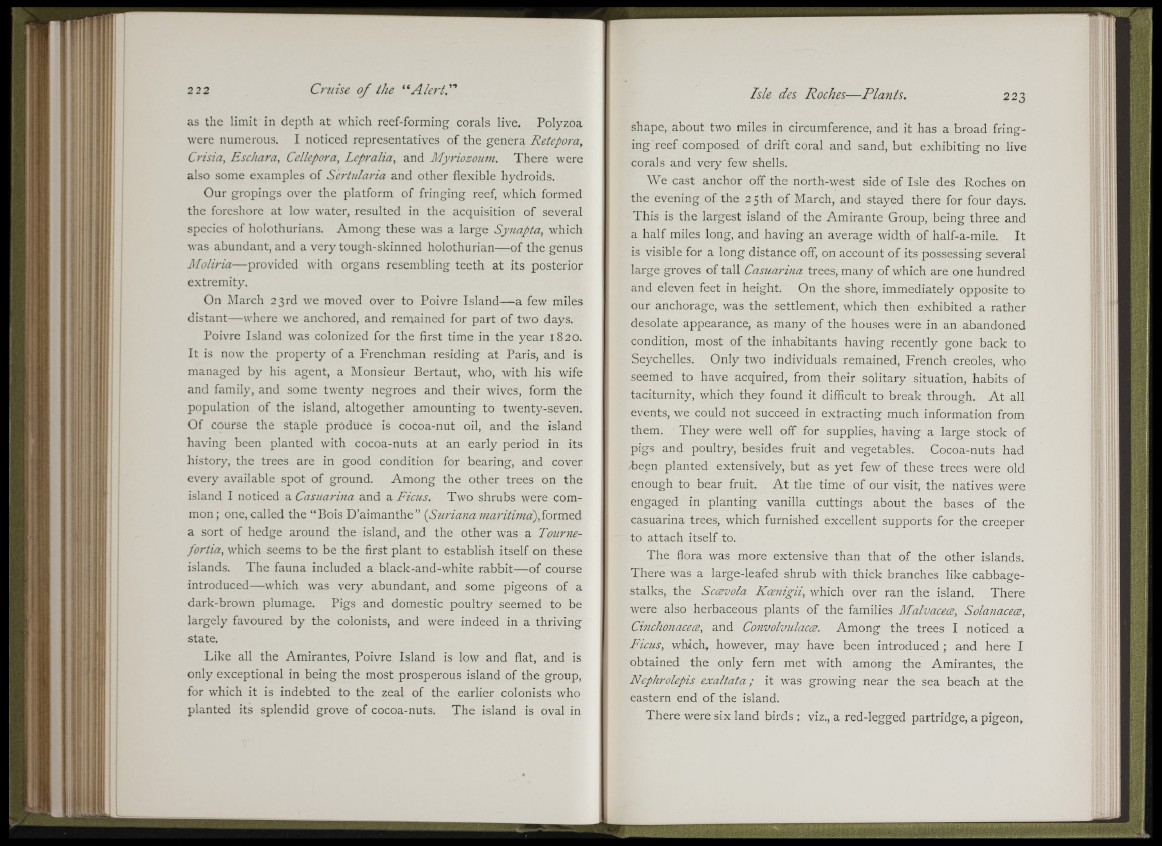
as the limit in depth at which reef-forming corals live. Polyzoa
were numerous. I noticed representatives of the genera Retepora,
Crisia, Eschara, Cellepora, Lepralia, and Myi-iozoiim. There were
also some examples of Sertularia and other flexible hydroids.
Our gropings over the platform of fringing reef, which formed
the foreshore at low water, resulted in the acquisition of several
species of holothurians. Among these was a large Synapta, which
was abundant, and a very tough-skinned holothurian— of the genus
Moliria— provided with organs resembling teeth at its posterior
extremity.
On March 23rd we moved over to Poivre Island— a few miles
distant— where we anchored, and remained for part of two days.
Poivre Island was colonized for the first time in the year 1820.
It is now the property of a Frenchman residing at Paris, and is
managed by his agent, a Monsieur Bertaut, who, with his wife
and family, and some twenty negroes and their wives, form the
population of the island, altogether amounting to twenty-seven.
Of course the staple produce is cocoa-nut oil, and the island
having been planted with cocoa-nuts at an early period in its
history, the trees are in good condition for bearing, and cover
every available spot of ground. Among the other trees on the
island I noticed a Casuarina and a Ficus. Two shrubs were common
; one, called the “ Bois D’aimanthe” {Suriana maritinia), formed
a sort of hedge around the island, and the other was a Tournefortia,
which seems to be the first plant to establish itself on these
islands. The fauna included a black-and-white rabbit— of course
introduced— which was very abundant, and some pigeons of a
dark-brown plumage. Pigs and domestic poultry seemed to be
largely favoured by the colonists, and were indeed in a thriving
state.
Fike all the Amirantes, Poivre Island is low and flat, and is
only exceptional in being the most prosperous island of the group,
for which it is indebted to the zeal of the earlier colonists who
planted its splendid grove of cocoa-nuts. The island is oval in
Isle des Roches— Plants. 223
shape, about two miles in circumference, and it has a broad fringing
reef composed of drift coral and sand, but exhibiting no live
corals and very few shells.
We cast anchor off the north-west side of Isle des Roches on
the evening of the 25th of March, and stayed there for four days.
This is the largest island of the Amirante Group, being three and
a half miles long, and having an average width of half-a-mile. It
is visible for a long distance off, on account of its possessing several
large groves of tall Casuarina trees, many of which are one hundred
and eleven feet in height. On the shore, immediately opposite to
our anchorage, was the settlement, which then exhibited a rather
desolate appearance, as many of the houses were in an abandoned
condition, most of the inhabitants having recently gone back to
Seychelles. Only two individuals remained, French creoles, who
seemed to have acquired, from their solitary situation, habits of
taciturnity, which they found it difficult to break through. A t all
events, we could not succeed in extracting much information from
them. They were well off for supplies, having a large stock of
pigs and poultry, besides fruit and vegetables. Cocoa-nuts had
■been planted extensively, but as yet few of these trees were old
enough to bear fruit. A t the time of our visit, the natives were
engaged in planting vanilla cuttings about the bases of the
casuarina trees, which furnished excellent supports for the creeper
to attach itself to.
The flora was more extensive than that of the other islands.
There was a large-leafed shrub with thick branches like cabbage-
stalks, the Sccevola Koenigii, which over ran the island. There
Avere also herbaceous plants of the families Malvacece, Solanacece,
Ciiichonacece, and Convolvulacce. Among the trees I noticed a
Ficus, which, however, may have been introduced ; and here I
obtained the only fern met with among the Amirantes, the
Nephrolepis exaltata; it was growing near the sea beach at the
eastern end of the island.
There were six land birds ; viz., a red-legged partridge, a pigeon,
iiHt